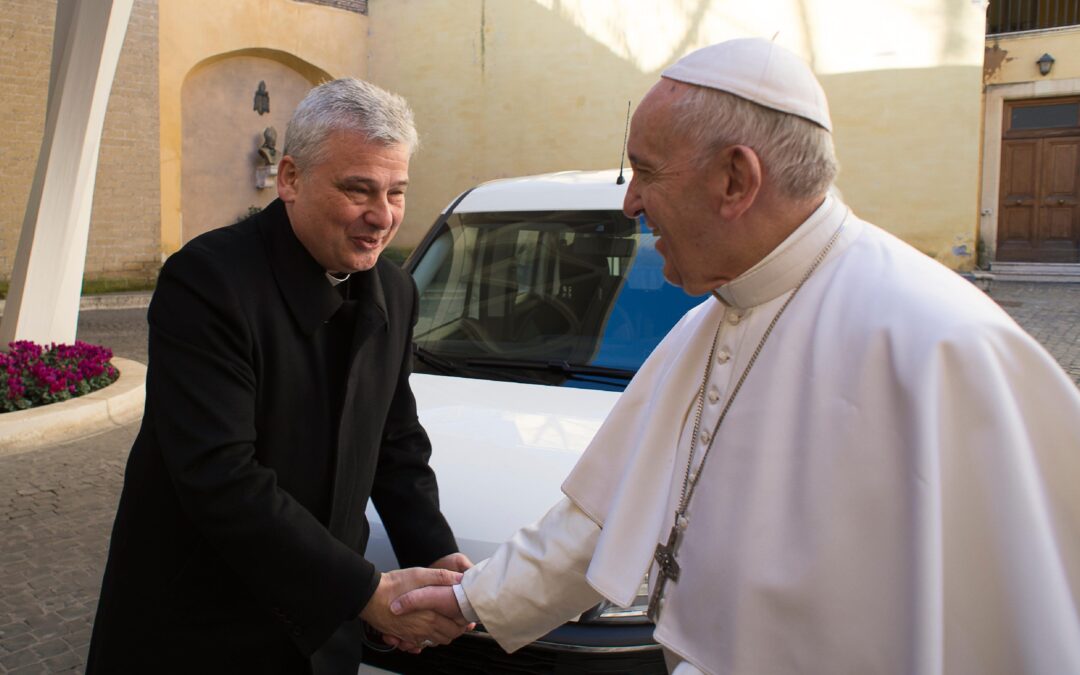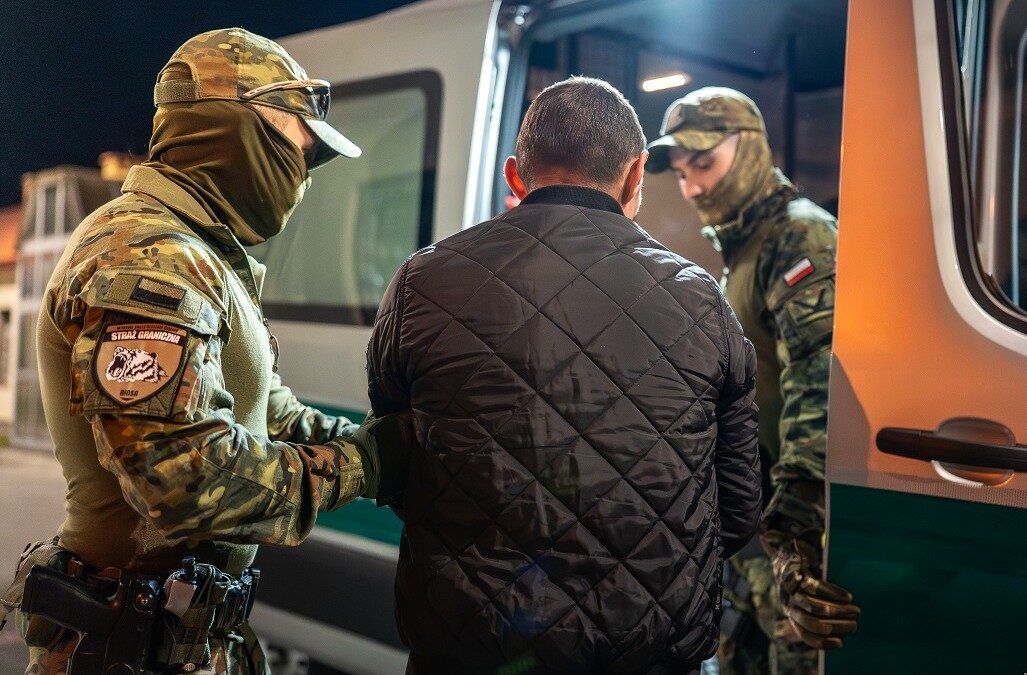By Filip Mazurczak
One day, the director of one of Italy’s largest shoe companies approached a Vatican prelate to say that he wanted to give a million euros to Pope Francis’ efforts to help the poor. Much to the man’s surprise, the archbishop declined the offer, telling him that this sum of money would have a negligible impact. “Alms have to hurt,” he explained.
Instead, the archbishop suggested that the businessman find out which of the 4,000 people employed in his factories were struggling to pay the rent or could not afford their children’s school lunches, and then divide the money among them.
A month later, the businessman called back to say that though he was unable to find this information about his employees, something the archbishop had said about the twisted and diseased feet of the homeless and their struggle to find well-fitting shoes had been weighing on him. In response, the archbishop suggested that he design a series of shoes for the poor that are wide at the arches of the foot. He agreed, and a team of volunteers distributed 10,000 of the custom-made pairs to Rome’s homeless.
The archbishop was Konrad Krajewski, the papal almoner, or director of the pope’s charitable works, and one of the most intriguing figures in the Vatican today. He told this anecdote at a meeting in Łódź but never revealed the identity of the businessman.
The Almoner of His Holiness
From time immemorial, political, religious, and civic leaders have spoken about the need to aid the poor. Very often, these are merely empty words, but over Krajewski’s time in the office of the papal almoner, he has built a record of helping the needy with determination and creativity. From installing showers for the homeless at the Vatican to helping refugees, the Łódź native has transformed the office of papal almoner from an obscure post to a vocal mouthpiece advocating for Rome’s and the world’s poor.
His methods have been known to be unconventional. In May of last year, Krajewski climbed down a manhole in a Roman residential building and broke a seal put in place by an energy provider to restore electricity and hot water. These utilities had been cut off for five days because its 450 inhabitants, including one hundred children – migrants and homeless Romans who had lived there since 2013 – owed €300,000 in unpaid electricity bills.
Polish Cardinal Konrad Krajewski, an aide to Pope Francis, broke a police seal and climbed down a manhole during the night in order to restore electricity to hundreds of homeless people occupying a building.
His actions were criticised by @matteosalvinimi https://t.co/Z7Ljv1HsBk
— Notes from Poland 🇵🇱 (@notesfrompoland) May 13, 2019
He has at times alienated even his most natural allies. “Supporting illegal conduct is never a good signal,” Matteo Salvini, leader of Italy’s nationalist Lega Nord party, who is famously fond of defending Italy’s and Europe’s Christian heritage, grumbled in response to Krajewski’s gesture. “There are lots of Italian people and legally resident immigrants who pay their bills, even if they are in difficulty.”
Krajewski, in turn, said he had no regrets, explaining that the plight of these poor Romans moved him so profoundly that the letter of the law became of secondary importance to him.
The story immediately made it to the front page of La Repubblica, Italy’s biggest left-wing newspaper, not known for affection for the Catholic Church. The paper dubbed Krajewski “the pope’s Robin Hood.”
Breaking the law to create more humane living conditions for hundreds of homeless and migrants illustrates Cardinal Krajewski, who has been increasingly present in international headlines since his appointment as the director of the pope’s charitable works in 2013.
Konrad Krajewski was born into a working-class family in Łódź in 1963. In 1987, while still just a seminarian, he served as the master of ceremonies during Pope John Paul II’s Mass in his hometown. He spent the next decade serving as a parish priest in the Archdiocese of Łódź, studying liturgics and theology in Rome, and working as a master of ceremonies and the library director in his archdiocese. In 1999, John Paul II appointed him Papal Master of Ceremonies.
Although at this time, Krajewski’s official duties were not centred on helping the poor, immediately upon his arrival at the Vatican in 1998, talk of a priest who buys food for the homeless camping out near St. Peter’s Square began to spread around Rome.
Krajewski was also a participant in many notable events in recent Vatican history. During John Paul II’s funeral in 2005, he and his fellow Papal Master of Ceremonies, Archbishop Piero Marini, placed the Gospel Book on the late pope’s coffin. A sudden wind blew the book’s pages from cover to cover. For many in the audience and watching on television, this took on a tremendous symbolic significance.
Meanwhile, in the conclave that shortly followed, before the newly elected Pope Benedict XVI appeared on balcony of St. Peter’s Basilica, Krajewski appeared for the first time carrying a cross. Eight years later, he accompanied Cardinal Jean-Louis Tauran, when the latter announced that Cardinal Jorge Mario Bergoglio, Archbishop of Buenos Aires, had been elected Pope Francis. Five months after becoming pope, Francis appointed Father Krajewski as papal almoner and elevated him to the status of archbishop.
The Almoner of His Holiness is a very old office, dating back to the Middle Ages. It is responsible for the coordination of the pope’s charitable efforts. Until Krajewski, however, few people unversed in Church history even knew that such a function existed.
Polish Cardinal Konrad Krajewski, known as the "Pope’s Robin Hood" for his work with the needy, helped feed transsexual prostitutes during lockdown.
“I don’t understand why this is getting so much attention,” he says. “This is normal work for the Church” https://t.co/FxmAXfM7Oi
— Notes from Poland 🇵🇱 (@notesfrompoland) May 3, 2020
Because of his work, Krajewski has greatly increased the profile of his office. In 2014, he installed showers for the homeless at St. Peter’s Square. The idea came to him a day after Mass when a homeless man who had been living on Rome’s streets for years told him it was his fiftieth birthday. When Krajewski proposed to invite him to dinner, the man replied that no restaurant would let him in because of his body odour.
Early on, Pope Francis asked Krajewski to transform the Palazzo Migliore next to the colonnade of St. Peter’s Square into a “Palace for the Poor,” where at least fifty homeless people could sleep and where volunteers could serve hot meals to the poor. Meanwhile, in Bangui in the Central African Republic, the cardinal attended the inauguration of a hospital for starving children founded on Pope Francis’ initiative.
“Although he gives beautiful sermons, Cardinal Krajewski evangelises other people above all through his gestures rather than his words,” says Krzysztof Tadej, a Polish journalist and the editor of Zapach Boga (“The Scent of God”), a compilation of Krajewski’s different homilies and speeches that has become a bestseller in Poland. “His strength comes from the Gospels and God, helping others comes from this thinking according to the Gospels.”
Both in Italy and in Krajewski’s native Poland, politicians claiming to be defenders of Catholic values have vocally declined to accept refugees from the Middle East and Africa. Cardinal Krajewski, like Pope Francis, has been an advocate for them. “In Poland, we are divided on the topic of people who don’t even exist here: refugees,” he said during a retreat for priests from the Archdiocese of Łódź two years ago.
Since the refugee crisis began, he has visited Lampedusa, the Mediterranean island between Sicily and Africa that is a destination of many refugees, to aid those fleeing persecution and to give those who drowned a decent burial. More recently, he travelled to the Aegean island of Lesbos to take thirty-three refugees to Rome, where they will be looked after by the Vatican and the Catholic Sant’Egidio Community.
“For me, Cardinal Krajewski is an excellent example of how passion for the liturgy consequently leads to engagement in works of charity and influences a sense of social responsibility. Before becoming pope, Cardinal Joseph Ratzinger wrote about this beautifully,” says Dawid Gospodarek, editor of Poland’s Catholic Information Agency and of the Polish edition of the Catholic magazine Magnificat.
A second Polish pope?
When Pope Francis named Krajewski a cardinal in 2018, Poland’s Rzeczpospolita newspaper published an article titled: “Cardinal Konrad Krajewski: Can There Be a Second Polish Pope?” Krajewski has many traits that would make him an attractive pope. While he has worked in the Vatican for over two decades, he stands in contrast to the image of the out-of-touch Vatican bureaucracy.
Apart from his time in Rome, Krajewski has ample pastoral experience, and arguably more than any other high-ranking Vatican official. Furthermore, two thirds of the world’s Catholics currently live in the global South: Latin America, Africa, and Asia. Most countries in these regions are poor, sometimes desperately so, and a pope whose ministry has involved aiding the destitute could understand the problems of Catholics in developing nations well.
Interestingly, in 2016, John L. Allen, Jr., one of the best-connected and most influential Vatican watchers in the United States and perhaps the entire English speaking world, argued that Krajewski could be a conceivable successor to Francis, noting, however, that on the surface, Krajewski’s election “seems a silly idea” because of his youth and the fact that he is not a cardinal.
In the three years since the publication of that article, Krajewski has received the red biretta worn by cardinals. His youth, though, is still potentially a problem. Fifty-six years old, if he were elected pope now a pontificate lasting three decades is plausible. Furthermore, although for many cardinals Krajewski is too young to be pope now, that will not be the case in fifteen or twenty years.
A potentially larger handicap to Krajewski’s election to the papacy is his nationality; after a Polish pope had governed the Catholic Church for more than a quarter-century in recent memory, the cardinals may be hesitant to give such privilege to one country.
Regardless of whether Krajewski assumes a higher office, he has left a permanent mark on the office of the papal almoner, transforming it from an unknown position to a source of charity in Rome.
Main image credit: Vatican media handout





















